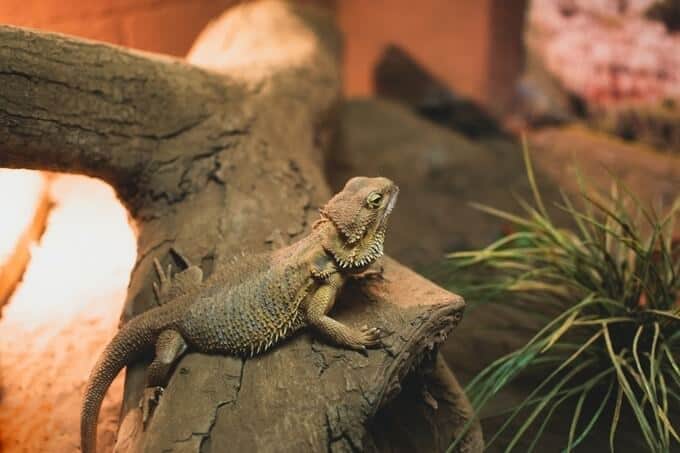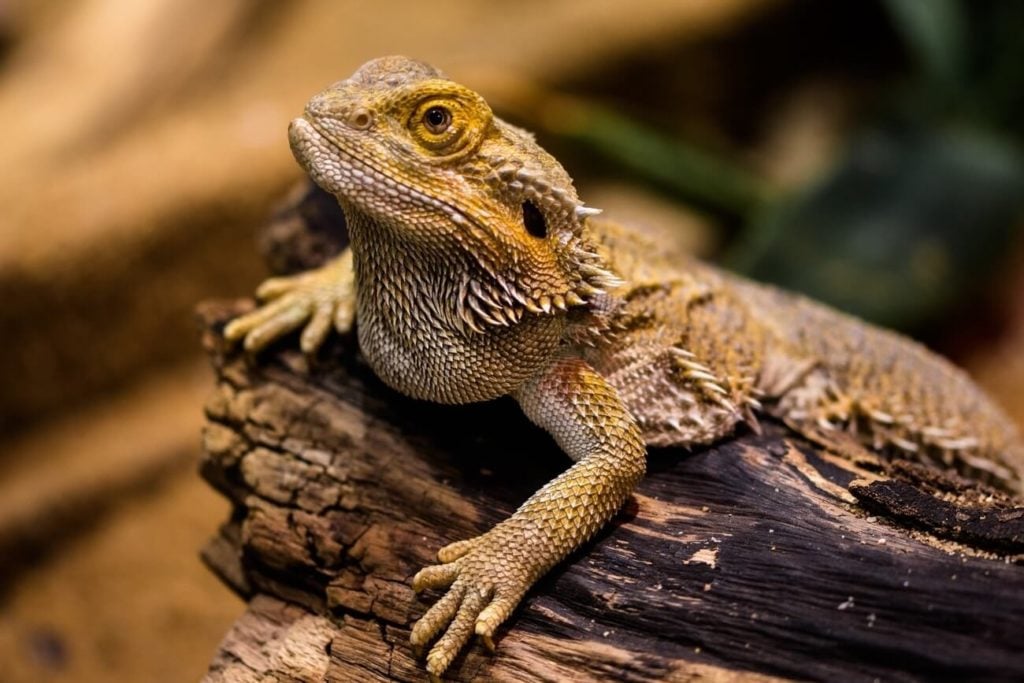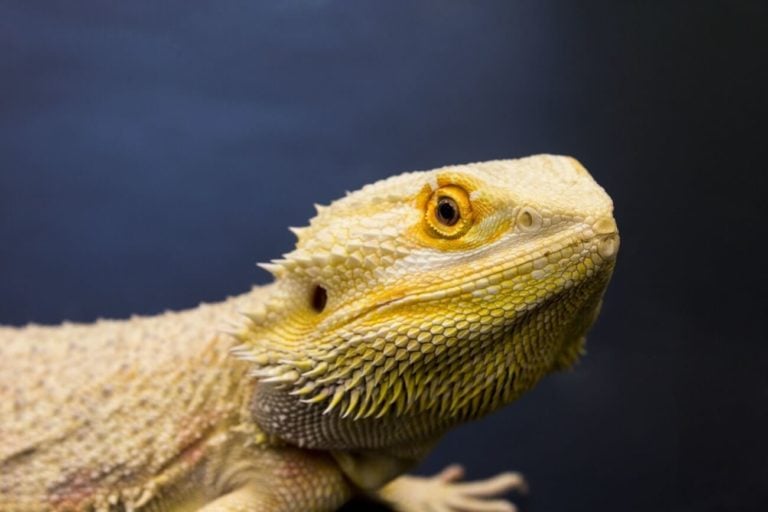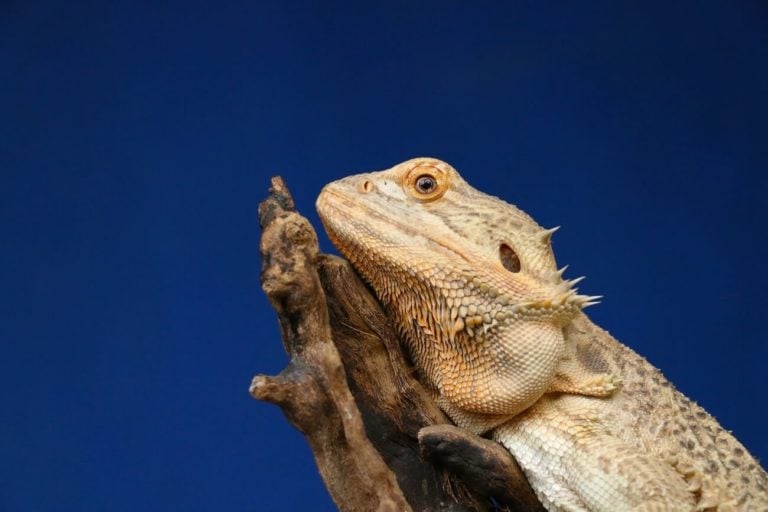Finding and maintaining the perfect bearded dragon humidity is one of the most important jobs an owner has.
That’s because the right humidity level is not only a comfort requirement for these reptiles, but a health requirement as well. When bearded dragons are exposed to humidity that is too high or too low, they can quickly develop a series of health issues (mostly respiratory).
Fortunately, there’s no excuse for this to happen if you know what you’re doing.
This guide will teach you everything you need to know about humidity and bearded dragons, so you can provide them with a healthy and comfortable home!
Table of Contents
The Ideal Humidity For Bearded Dragons
Bearded dragons are native to the wild and arid outback region of Australia. That means these lizards cannot tolerate humidity levels that fall significantly outside of this range.
Because of this, it’s essential to closely monitor the humidity levels in your beardie’s tank to keep your little friend healthy and happy.
To ensure that your bearded dragon habitat closely mimics their natural environment, the relative humidity levels should remain at 35 to 40 percent.
This humidity level is similar to the hot dry inland geographical regions of Australia, which will help keep your beardie in the best of health. High humidity levels can increase the chances of serious respiratory problems for your vulnerable bearded dragon among other adverse issues.
Expert Tip: Due to the importance of maintaining the humidity levels for your bearded dragon, avoid putting them in an all-glass tank with a glass or plastic top cover. These covers tend to increase the humidity inside the tank or terrarium by trapping the moisture inside.
The Best Way To Monitor Humidity
Before bringing your pet bearded dragon home, be sure to invest in a reliable and accurate hygrometer. A hygrometer is a measuring instrument designed to accurately measure the water vapor in the air, soil, or confined spaces such as an enclosed reptile tank.

These instruments are typically calibrated to measure relative humidity (RH for short). The instrument measures the amount of water vapor relative to the maximum temperature via a percentage reading.
- Made with accuracy in mind
- Easy to read digital display
- Comes with waterproof probe
- Battery included and ready to use
You’ll typically have two different types of hygrometers to select from:
- Psychrometer
- Mechanical Hygrometer
While it’s not essential to know how they operate, we think it’s a good idea regardless. It will help you better understand what product you buy so you can have more confidence in your readings.
Psychrometer
This type of hygrometer contains two thermometers. One is a wet bulb, and the other is a dry bulb.
This setup works by measuring the temperature changes from one bulb to the other. The temperature inside the tank will decrease as moisture in the air evaporates, which is indicated by the readings of the wet bulb.
Mechanical Hygrometer
The mechanical hygrometer utilizes hairs or another type of fiber to measure humidity changes.
Some of the more expensive hygrometers even have wireless sensors that can connect to your Android phone to get real-time readings. Others require more effort to ensure that the sensor probes are placed correctly inside the tank.
What Happens If The Humidity Is Too High?
Like other animals, bearded dragons can become uncomfortable if the humidity level in their environment becomes too high.
But if this condition continues, these reptiles can develop respiratory infections and related respiratory ailments. This can not only impact their health in the short term, but it can lead to a shorter lifespan.
This makes it important to closely monitor and maintain your beardie’s living environment to keep it as close to its natural habitat as possible. This will prevent respiratory issues and keep your little reptile happy and comfortable in their new home.
How To Lower The Humidity In A Bearded Dragon Tank
Humidity levels are subject to change, and keeping them stable can be a bit tricky thing for first-time beardie owners to master. If something does go amiss and the tank conditions do become too humid, there are a number of ways to decrease the humidity level inside of the tank.
The main methods to lower the humidity in bearded dragon tanks are:
- Increase Ventilation
- Move Water Bowl Away from Heat Sources
- Switch to a Different Substrate
- Stop Misting Until Humidity is Back Under Control
- Try Using a Dehumidifier
In the following sections, we look at each of these methods and how to do them properly.
Increase Ventilation
After checking your hygrometer readings to ensure that your humidity levels are accurate, try increasing the ventilation to lower the humidity in the tank.
Expert Tip: This can be more difficult in glass tanks. Don’t use a glass or plastic full cover, and switch to a mesh cover if at all possible.
You can also try opening room windows or turning on a fan or adjusting the AC if the room temperature seems to be the issue. It may be necessary to move the tank into another room where the humidity level is better.

Remember that plants tend to increase the air humidity near where they are placed. If you want to lower the humidity levels, try moving the plants to another region of the tank or remove them altogether until the humidity gets back under control.
This also includes any room live plants that may be present, not just the plants inside the tank itself. You’ll probably need a lot of plants in the room for this to be possible, but it’s worth pointing out.
It may be necessary to invest in special vents and fans to properly maintain humidity and temperature levels. It also helps to ensure that there is adequate space surrounding the tank’s hide box area and basking regions to allow the humid air to escape.
Move Their Water Bowl Away From Heat Sources
As you probably know, the tank should have a cooling side and a warmer side. If humidity levels begin to climb, move the water bowl away from any heat sources inside of the tank or near to the tank walls.
While it seems simple, this can go a long way towards lowering the humidity levels a bit.
As water evaporates, the immediate air surrounding the water source will absorb the moisture thereby increasing the elevated humidity levels. Water bowls should not be placed near any lights you’re using if you’re having issues keeping humidity levels low.
It’s also a good idea to avoid using an extremely large water bowl for your bearded dragon (relative to the size of their enclosure). Too much water in a smaller enclosed space will naturally get absorbed into the air. Try using a smaller sized water bowl instead and checking it often.
Expert Tip: Lastly, consider slightly increasing the temperature of the basking bulb. This can help lower the humidity as well.
Switch To A Different Substrate
Certain substrates tend to retain moisture and cause an increase in humidity. Typical culprits are bark and coconut substrate materials.
While we’re not saying you shouldn’t use these substrate materials, a switch should be considered if high humidity is a recurring problem. Always prioritize the health of your beardie when making decisions about their habitat setup.
Stop Misting Until The Humidity Is Under Control
Part of the care of a bearded dragon is to mist them and their tanks from time to time. However, doing this has an obvious impact on the humidity level.
If you’re having trouble keeping the humidity under control, it’s a good idea to stop this misting until the tank it’s under control again. This is an easy fix that can make a big difference!
Try A Dehumidifier
If all of the above measures fail, consider using a dehumidifier. It’s possible for most owners to lower the humidity in their bearded dragon tank without this, but it’s worth noting.
Most of the owners we know who’ve had to resort to a dehumidifier tend to live in regions where the humidity is naturally high.
How To Increase The Humidity In Their Tank
On the other hand, there will be times when your hygrometer readings are telling you that your tank conditions are becoming too dry. This can also cause a number of health issues for your bearded dragon, so it’s an important issue to address.
There are a number of easy methods to raise the humidity levels in the tank. These humidity raising methods include:
- Placing Their Water Near the Hot Side of the Tank
- Mist More Frequently
- Consider Adding Plants
These methods are quite easy and can be implemented by beardie owners with little experience.
Place Their Water Near The Hot Side Of The Tank
Just as placing water in cooler areas of the tank can help lower humidity, intentionally placing it near a heat source can help raise it. This is a very straightforward fix that can be put in place in a matter of minutes. If you have to do any shuffling of decorations in the enclosure, it’s worth it!
Expert Tip: It may be necessary to play around with the perfect spot for the water bowl in relation to the light and heat sources. You might also need to experiment with different light placement to make things work.
Mist More Frequently
Try misting your little pet’s tank walls more frequently when the humidity level is too low. Not only will this quickly increase the humidity level in the area, but it will also make your little friend happy as well!
In the wild, dragons will find places to hide that have higher humidity levels, and they’re often seen basking near water sources when the temperatures climb and humidity levels decrease to restore the moisture being lost.
Invest in a misting bottle to help keep your beardie refreshed when the air becomes too dry (even for a lizard). It is alright to gently mist near or even on your dragon when the temperature climbs and humidity levels drop.
Expert Tip: We recommend using purified water if possible. This will help prevent mineral deposits from accumulating where water is sprayed, making it easier to keep your tank looking clean.
Add Plants To Their Habitat
Many plants naturally generate additional moisture to the air compared to the surrounding habitat. Therefore, adding plants to your tank can also raise humidity levels relatively quickly.
This is an easy method that does not take much time, effort, or expense. Plants that can be easily moved from one area of the tank to another are ideal.
You can also mist the plants directly since they will retain this moisture quite well (increasing the humidity as a result).
Time To Get To Work
Now that you have a strong understanding of bearded dragon humidity levels and how to change them, it’s time to start working!
If you already have a beardie, test the humidity in their enclosure and make any necessary adjustments. By now you know all the moves, so influencing these levels shouldn’t be too hard!
- Made with accuracy in mind
- Easy to read digital display
- Comes with waterproof probe
- Battery included and ready to use
If you don’t have a bearded dragon yet, buy a high-quality hygrometer and start setting up their new home. Use this period of time as a rehearsal for when you finally get your beardie!
We hope you learned a lot from this guide and feel like a more prepared owner. If you have any questions, feel free to reach out to us directly.



